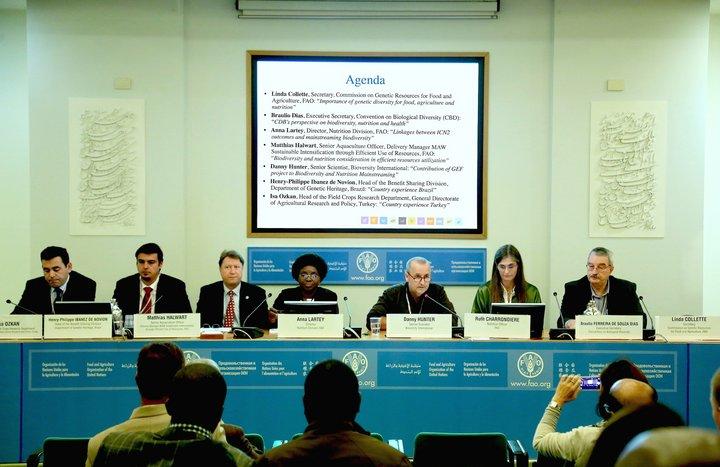A step closer to mainstreaming biodiversity for improved nutrition and health

Draft guidelines to mainstream biodiversity into policies, programmes, national and regional action plans were approved at the 15th Regular Session of the Commission on Genetic Resources for Food and Agriculture, taking place this week in Italy.
Draft guidelines for mainstreaming biodiversity into policies, programmes and national and regional action plans were approved at the 15th Regular Session of the Commission on Genetic Resources for Food and Agriculture, taking place this week in Italy. The guidelines will assist countries that recognize the importance of local foods - including wild, neglected and underutilized foods – to help address malnutrition, and mainstream biodiversity for food and agriculture into national and regional policies and programmes that target food security and nutrition. The guidelines will also help promote the knowledge, conservation, development and use of these nutritionally-rich varieties and breeds.
This announcement came just after Tuesday’s high-level side-event: ‘Mainstreaming biodiversity for improved human nutrition and well-being: Moving from global initiatives to local action’ organized by the Food and Agriculture Organization of the UN (FAO) with support from Bioversity International. Danny Hunter, Senior Scientist, Bioversity International, co-chair and Global Project Coordinator of the Biodiversity for Food and Nutrition Initiative (B4FN)* commented that “this approval marks an important step forward in recognizing the links between food biodiversity, the environment, human nutrition and healthy diets, but more is needed to be done. Much of this agricultural biodiversity, that is potentially rich in nutrition, is being lost at an unprecedented rate and ecosystems are being degraded”.
Braulio Ferreira de Souza Diaz, Executive Secretary, Convention on Biological Diversity, speaking at the event, warned that “we are losing biodiversity .... I believe that there is a lot we can do to restore ecosystems and foods that were once part of our traditional diets, but we need also to use science to understand how they fit nutritionally.”
Anna Lartey, Director Nutrition, FAO, explained how human diets today depend heavily on a narrow range of staple crops, with just rice, wheat and maize contributing more than 50% of the world’s calories from plants, even though throughout history, humans have used more than 7000 crops for food. This need to diversify diets was echoed by Ruth Charrondière, event co-chair, FAO, who said during her opening remarks that “we can achieve improved nutrition through dietary diversity”.
Brazil, Kenya, Sri Lanka and Turkey are four countries leading the way in this effort to embed biodiversity into national and global policies and programmes, through the Biodiversity for Food and Nutrition Initiative - a global initiative of the Global Environment Facility.
Henry-Philippe Ibanez de Novion, Ministry of Environment, Brazil, showcased how mainstreaming biodiversity at a national level through national policies and initiatives is positively impacting activities on the ground in Brazil, for example, through procurement policies such as the school feeding programme. “This programme not only promotes healthy eating habits in school, but also ensures that 30% of procurement is from local family farmers as opposed to large-scale suppliers to promote the production and consumption of diverse native species,” he explained.
Dr. İsa ÖZKAN, Head of Field Crops Research Department, Turkey also talked about the importance of data gathering “to promote locally available nutritionally-rich foods, enabling researchers and nutritionists to prepare healthy and diversified diets through consumption of nutrient-dense foods.”
Matthias Halwart, FAO, highlighted how biodiversity and nutrition are mainstreamed into FAO's new major area of work on 'Sustainable Intensification of Agriculture through Efficient Use of Resources'. He presented a case study of aquatic biodiversity in rice farming systems which represents an irreplaceable rich animal source food in the diet of millions of people and explained how small fish in particular which are eaten whole, including bones and head, can represent a very rich source of micronutrients.
Braulio Ferreira de Souza Diaz commented on the side-event’s success saying: “I think this event was important as part of a broader process to promote biodiversity for healthy diets especially to combat malnutrition … but of course we need to mobilize public policies to align better with these objectives. We also need to make better use of traditional knowledge and science to support these initiatives.”
Read the draft guidelines 'Mainstreaming biodiversity into policies, programmes and national and regional plans of action on nutrition'.
*The GEF 'Mainstreaming biodiversity for nutrition and health' initiative is led by Brazil, Kenya, Sri Lanka and Turkey and coordinated by Bioversity International, with implementation support from the United Nations Environment Programme (UNEP) and the Food and Agriculture Organization of the United Nations (FAO) and additional support from the CGIAR Research Program on Agriculture for Nutrition and Health. The Initiative works to address growing concerns over the rapid disappearance of traditional crops and wild species by promoting and lobbying for the use of nutritionally promising species, as well as by documenting the knowledge associated with the preparation, storage and cultural use of these foods.
Photo credit: Shawn Landersz
